Search the Blog
Latest Comments
Katrin
Spinning Speed Ponderings, Part I.
15. April 2024
As far as I know, some fabrics do get washed before they are sold, and some might not be. But I can'...
Kareina
Spinning Speed Ponderings, Part I.
15. April 2024
I have seen you say few times that "no textile ever is finished before it's been wet and dried again...
Katrin
How on earth did they do it?
27. März 2024
Ah, that's good to know! I might have a look around just out of curiosity.
I've since learned that w...
Heather Athebyne
How on earth did they do it?
25. März 2024
...though not entirely easy. I've been able to get my hands on a few strands over the years for Geor...
Katrin
Hieroglyphs.
23. Februar 2024
Yes, that would sort of fit that aspect - but you can also go from bits of woods to sticks if you ar...
Very Old Knitting, Part 5.
Slipping stitches is nice, and can be very helpful, but it takes time. Also, it tends to annoy me when I have to do an abundance of it... so I was thinking of alternative methods to get the new stitches to go through two previous ones, but without slipping stitches. I was thinking about just knitting into the row below in addition to the current row, or about having two needles parallel in the knitting... and, as we were hanging out together, I told the most patient husband of them all about this, and explained about the necessity to slip stitches with the other method because otherwise the stitch to discard won't go over the newer ones in the proper direction.
After mulling this over and thinking a minute about it, he asked "Why don't you just align them differently?" Brilliant man. So once I had yarn and needles handy again (this might have involved buying a set of simple metal needles to live in my handbag, because you can always find a use for metal sticks, and there was yarn in the bag already) I tried both my ideas (which did utterly not work, both of them, but it was interesting to see how spectacularly they failed to work) and then the different alignment.
So here you go, courtesy of the Most Patient of All Husbands, a second method to do compound knitting, with no slipping at all as long as you work in the round.
All stitches are aligned with the right leg behind the needle. The older stitch is now always on the left side, the newer stitch on the right side of the pair.
[caption id="attachment_2062" align="alignnone" width="640"]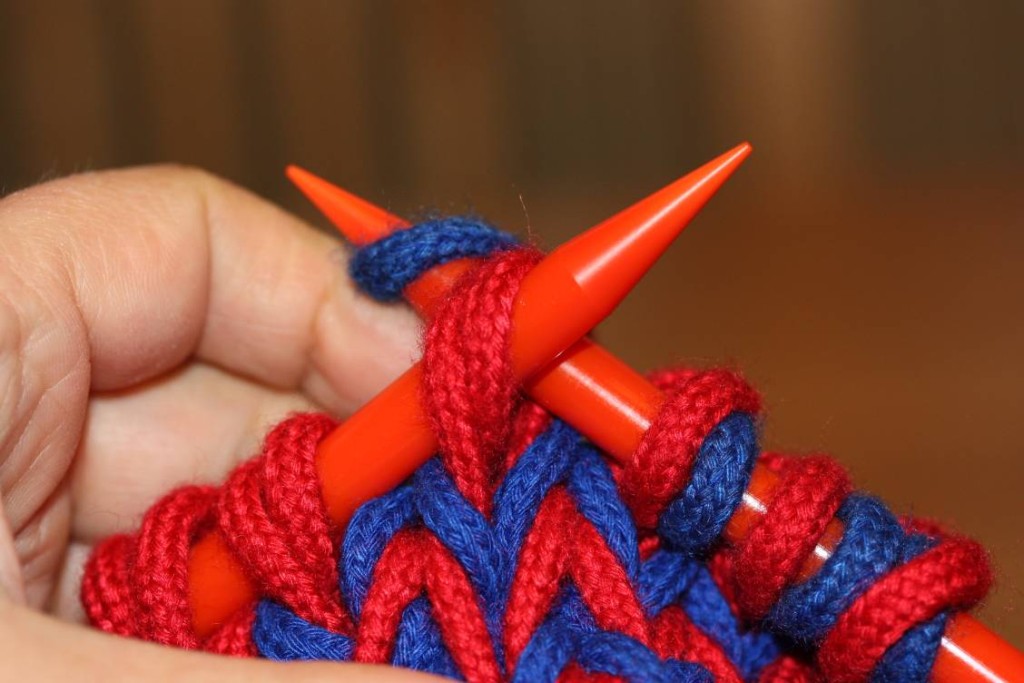 Insert right needle straight through both stitches on the left needle and wrap yarn from back to front (so the right leg of the new stitch will lie in the back)...
Insert right needle straight through both stitches on the left needle and wrap yarn from back to front (so the right leg of the new stitch will lie in the back)...
[caption id="attachment_2061" align="alignnone" width="640"]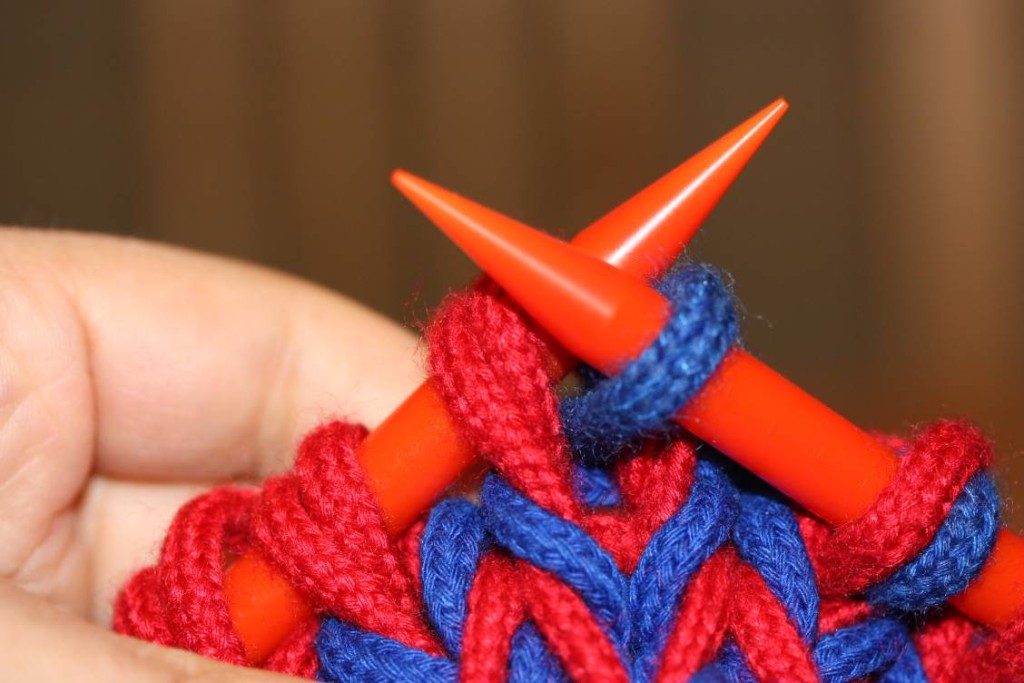 ...draw through both stitches on left needle...
...draw through both stitches on left needle...
[caption id="attachment_2060" align="alignnone" width="640"]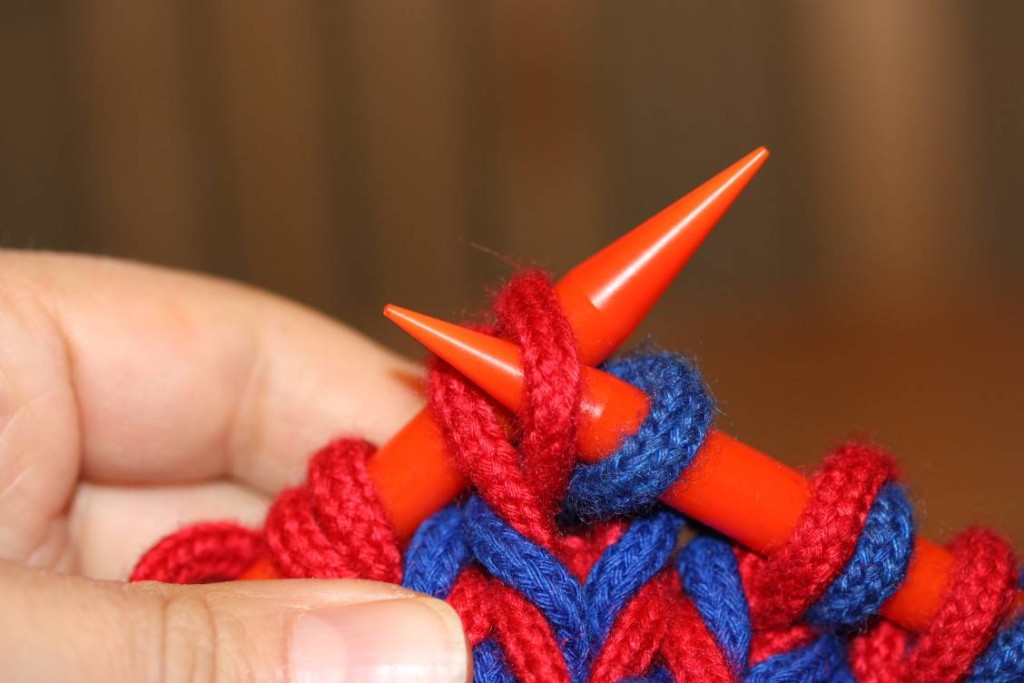 ...and move the first stitch on the left needle over to the right.
...and move the first stitch on the left needle over to the right.
[caption id="attachment_2059" align="alignnone" width="640"]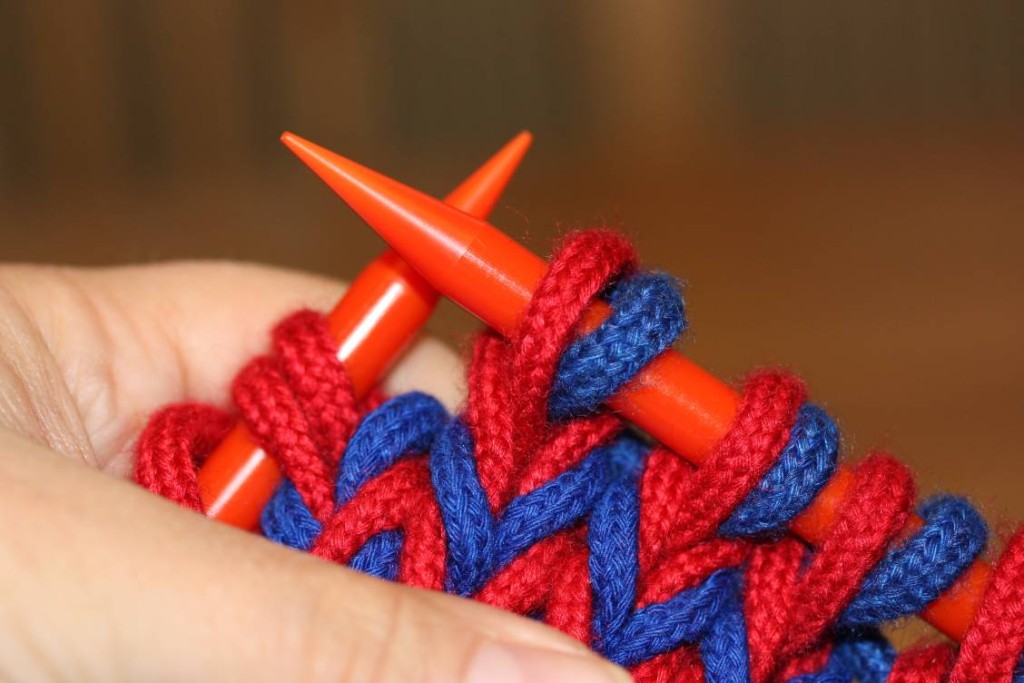 The new stitch lies on the right, the older stitch on the left.
The new stitch lies on the right, the older stitch on the left.
[caption id="attachment_2058" align="alignnone" width="640"]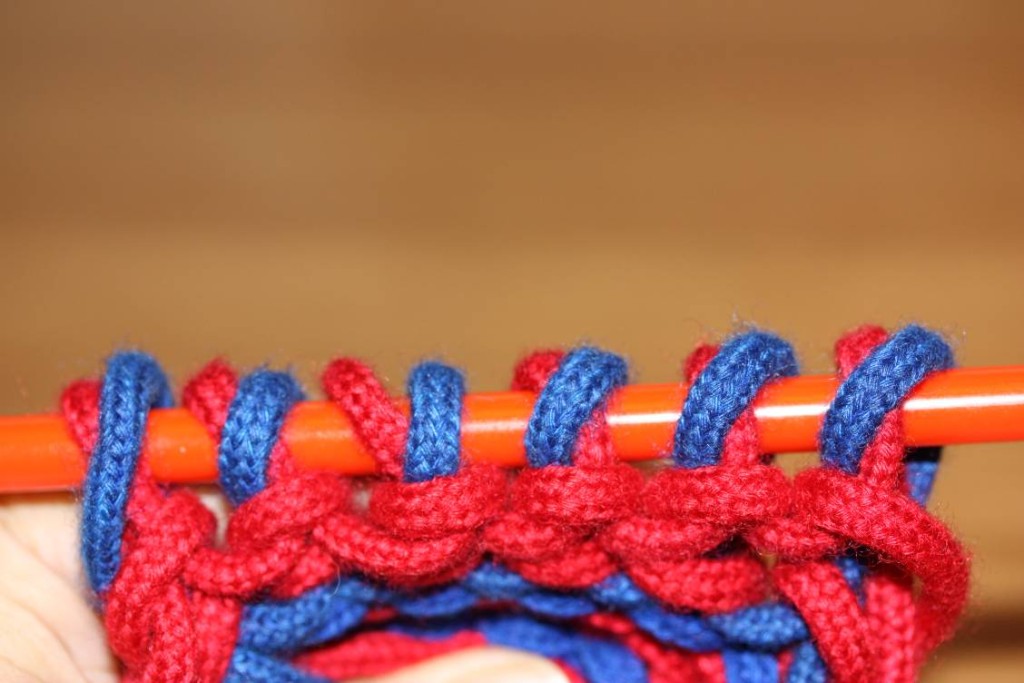 View from the back - you can see how the stitches sort of cross over each other on the needle.
View from the back - you can see how the stitches sort of cross over each other on the needle.
This is nice and relatively fast to work, and involves no slipping. There is a little danger of stitches swapping positions, though, especially in the first and last stitch of the row, mostly due to them being much looser. Knitting in the round eliminates that problem, and it also lets you work without having to deal with a return row, because that... well. That's an entirely different beast.
To get the stitches that have to be discarded to move over their new counterparts in the correct direction, there needs to be some slipping of stitches again. I tried doing a return row, similar in method to the original instructions, and lo and behold - there were twisted stitches again:
[caption id="attachment_2057" align="alignnone" width="640"]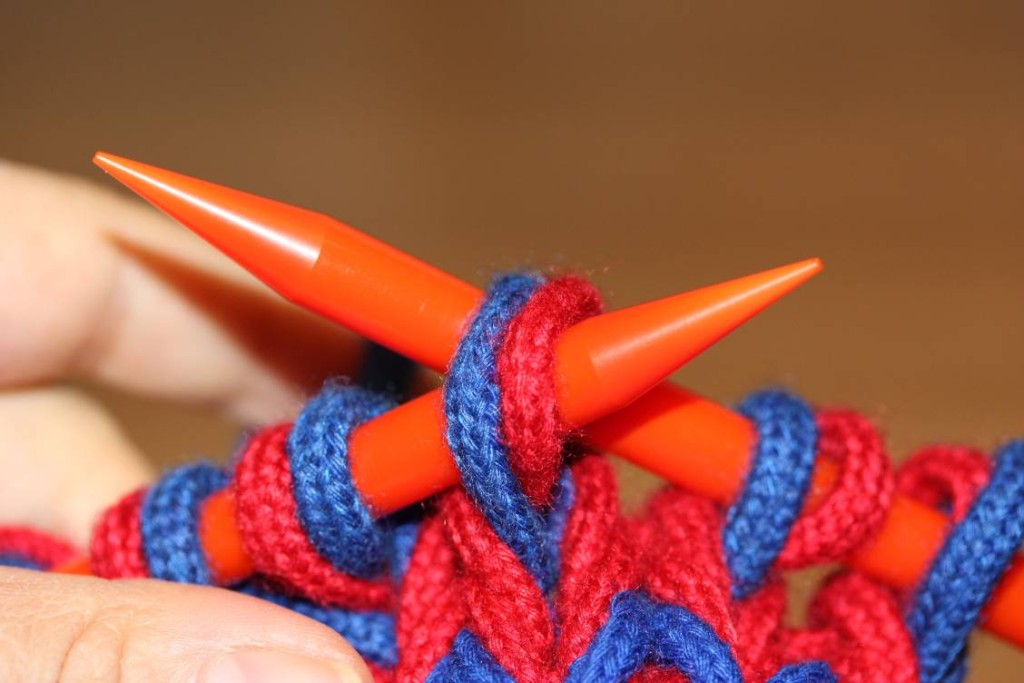 Insert left needle through both stitches on right needle.
Insert left needle through both stitches on right needle.
[caption id="attachment_2056" align="alignnone" width="640"]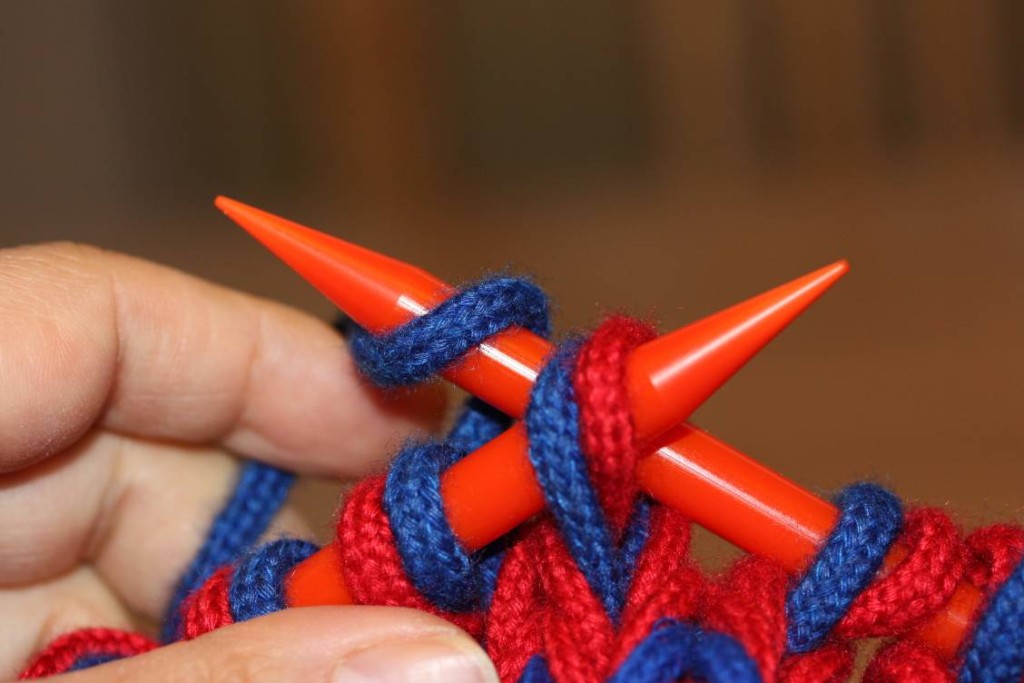 Wrap yarn from back to front around right needle, pull through both stitches...
Wrap yarn from back to front around right needle, pull through both stitches...
[caption id="attachment_2055" align="alignnone" width="640"]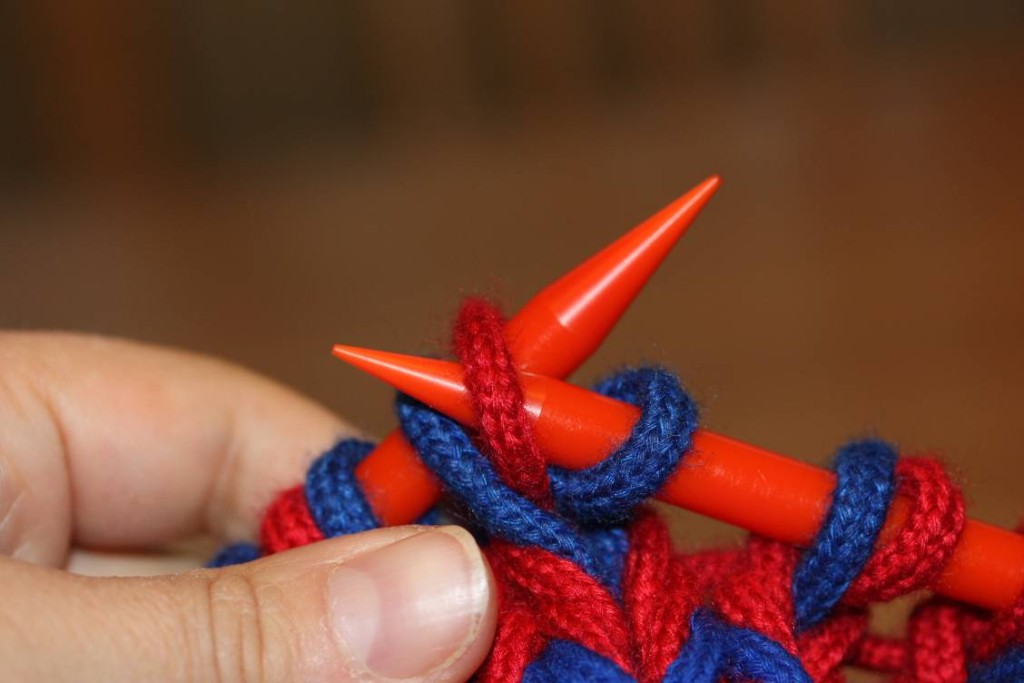 ... and transfer first stitch on left needle to right, dropping the second stitch off the needles.
... and transfer first stitch on left needle to right, dropping the second stitch off the needles.
[caption id="attachment_2054" align="alignnone" width="640"]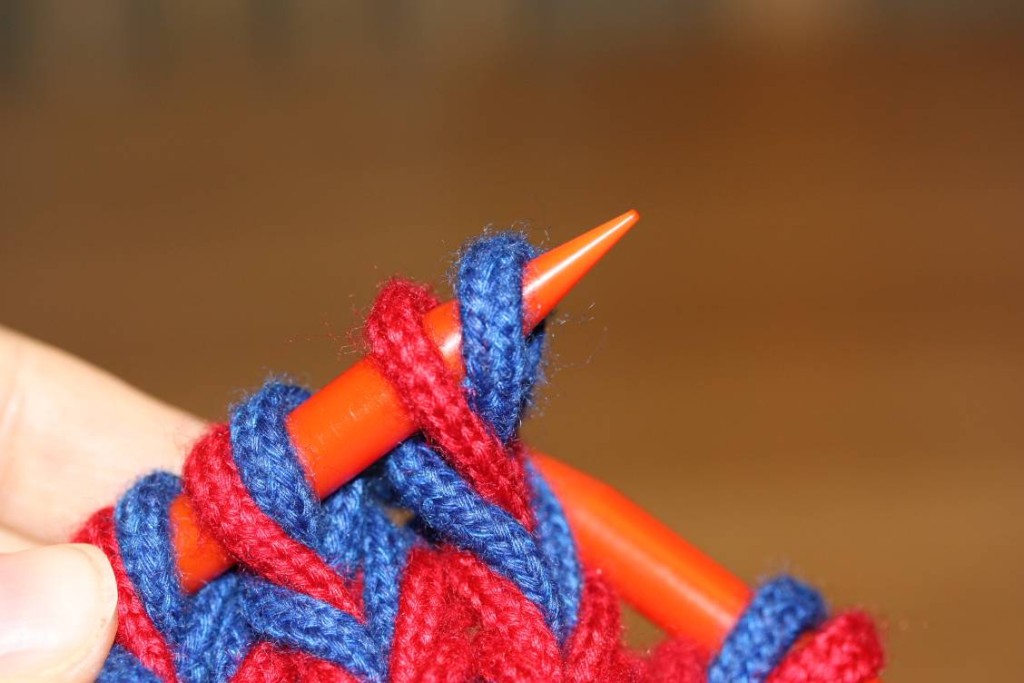 Then transfer both stitches to the left needle.
Then transfer both stitches to the left needle.
[caption id="attachment_2053" align="alignnone" width="640"]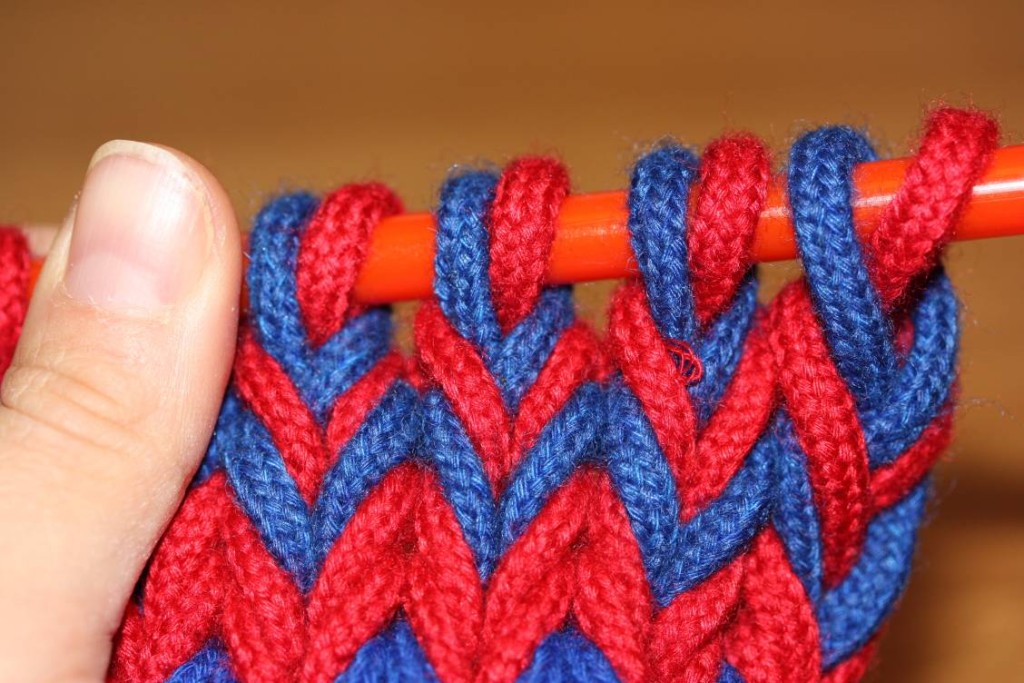 The result after one more regular row: after the return row, the stitches that were worked in the return row are twisted...
The result after one more regular row: after the return row, the stitches that were worked in the return row are twisted...
I'm quite sure that the twisted-stitch issue can be resolved by different alignment or some other shenanigans. There remains, however, an interesting fact: no matter which method, the original or this one, working in one direction only is much easier than turning around and working knitting in the flat. So knitting with stitches through two previous rows instead of just one seems to be much better suited to working in the round, not in the flat.
Which sort of fits into the picture of early knitting being done in the round only, as far as we can tell from our evidence. So maybe there was a point in time when flat knitting, going back and forth in rows, was developed and it didn't work so well with the stitches in double depth, leading to the development of the knitting through just one previous row? Who knows - but maybe, some day, we'll have a few more knitting finds to help with these questions.
I hope you enjoyed this series about knitting - and if you find a better method, or a good way of working the return row, please let the rest of us know in the comments!
After mulling this over and thinking a minute about it, he asked "Why don't you just align them differently?" Brilliant man. So once I had yarn and needles handy again (this might have involved buying a set of simple metal needles to live in my handbag, because you can always find a use for metal sticks, and there was yarn in the bag already) I tried both my ideas (which did utterly not work, both of them, but it was interesting to see how spectacularly they failed to work) and then the different alignment.
So here you go, courtesy of the Most Patient of All Husbands, a second method to do compound knitting, with no slipping at all as long as you work in the round.
All stitches are aligned with the right leg behind the needle. The older stitch is now always on the left side, the newer stitch on the right side of the pair.
[caption id="attachment_2062" align="alignnone" width="640"]
 Insert right needle straight through both stitches on the left needle and wrap yarn from back to front (so the right leg of the new stitch will lie in the back)...
Insert right needle straight through both stitches on the left needle and wrap yarn from back to front (so the right leg of the new stitch will lie in the back)...[caption id="attachment_2061" align="alignnone" width="640"]
 ...draw through both stitches on left needle...
...draw through both stitches on left needle...[caption id="attachment_2060" align="alignnone" width="640"]
 ...and move the first stitch on the left needle over to the right.
...and move the first stitch on the left needle over to the right.[caption id="attachment_2059" align="alignnone" width="640"]
 The new stitch lies on the right, the older stitch on the left.
The new stitch lies on the right, the older stitch on the left.[caption id="attachment_2058" align="alignnone" width="640"]
 View from the back - you can see how the stitches sort of cross over each other on the needle.
View from the back - you can see how the stitches sort of cross over each other on the needle.This is nice and relatively fast to work, and involves no slipping. There is a little danger of stitches swapping positions, though, especially in the first and last stitch of the row, mostly due to them being much looser. Knitting in the round eliminates that problem, and it also lets you work without having to deal with a return row, because that... well. That's an entirely different beast.
To get the stitches that have to be discarded to move over their new counterparts in the correct direction, there needs to be some slipping of stitches again. I tried doing a return row, similar in method to the original instructions, and lo and behold - there were twisted stitches again:
[caption id="attachment_2057" align="alignnone" width="640"]
 Insert left needle through both stitches on right needle.
Insert left needle through both stitches on right needle.[caption id="attachment_2056" align="alignnone" width="640"]
 Wrap yarn from back to front around right needle, pull through both stitches...
Wrap yarn from back to front around right needle, pull through both stitches...[caption id="attachment_2055" align="alignnone" width="640"]
 ... and transfer first stitch on left needle to right, dropping the second stitch off the needles.
... and transfer first stitch on left needle to right, dropping the second stitch off the needles.[caption id="attachment_2054" align="alignnone" width="640"]
 Then transfer both stitches to the left needle.
Then transfer both stitches to the left needle.[caption id="attachment_2053" align="alignnone" width="640"]
 The result after one more regular row: after the return row, the stitches that were worked in the return row are twisted...
The result after one more regular row: after the return row, the stitches that were worked in the return row are twisted...I'm quite sure that the twisted-stitch issue can be resolved by different alignment or some other shenanigans. There remains, however, an interesting fact: no matter which method, the original or this one, working in one direction only is much easier than turning around and working knitting in the flat. So knitting with stitches through two previous rows instead of just one seems to be much better suited to working in the round, not in the flat.
Which sort of fits into the picture of early knitting being done in the round only, as far as we can tell from our evidence. So maybe there was a point in time when flat knitting, going back and forth in rows, was developed and it didn't work so well with the stitches in double depth, leading to the development of the knitting through just one previous row? Who knows - but maybe, some day, we'll have a few more knitting finds to help with these questions.
I hope you enjoyed this series about knitting - and if you find a better method, or a good way of working the return row, please let the rest of us know in the comments!
Comments
No comments made yet. Be the first to submit a comment



